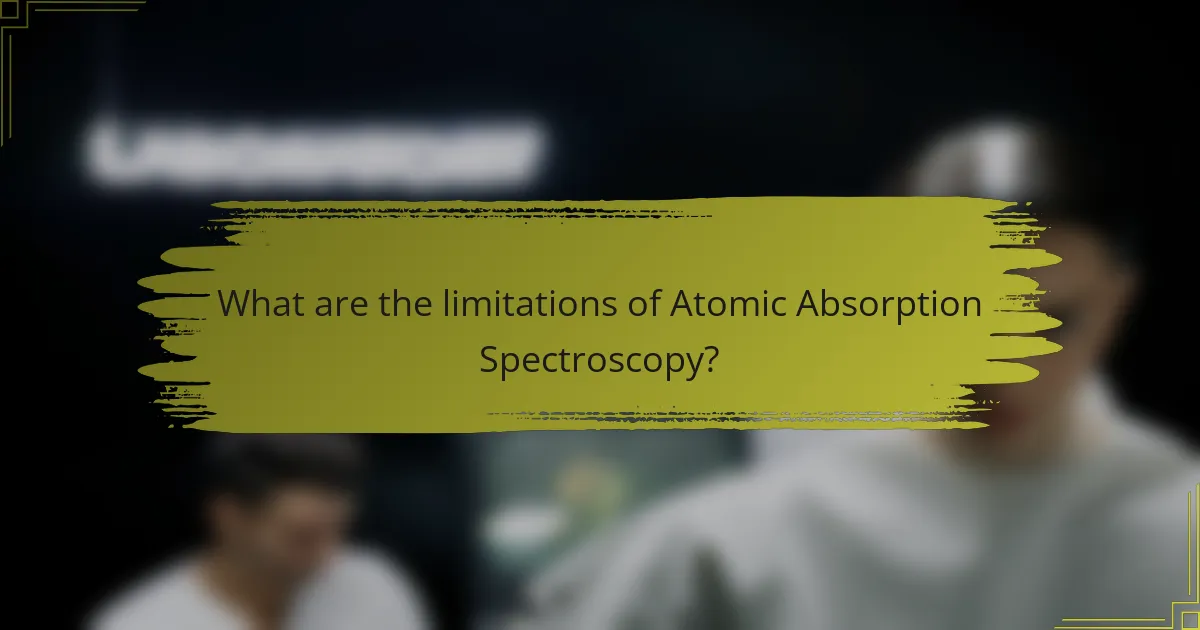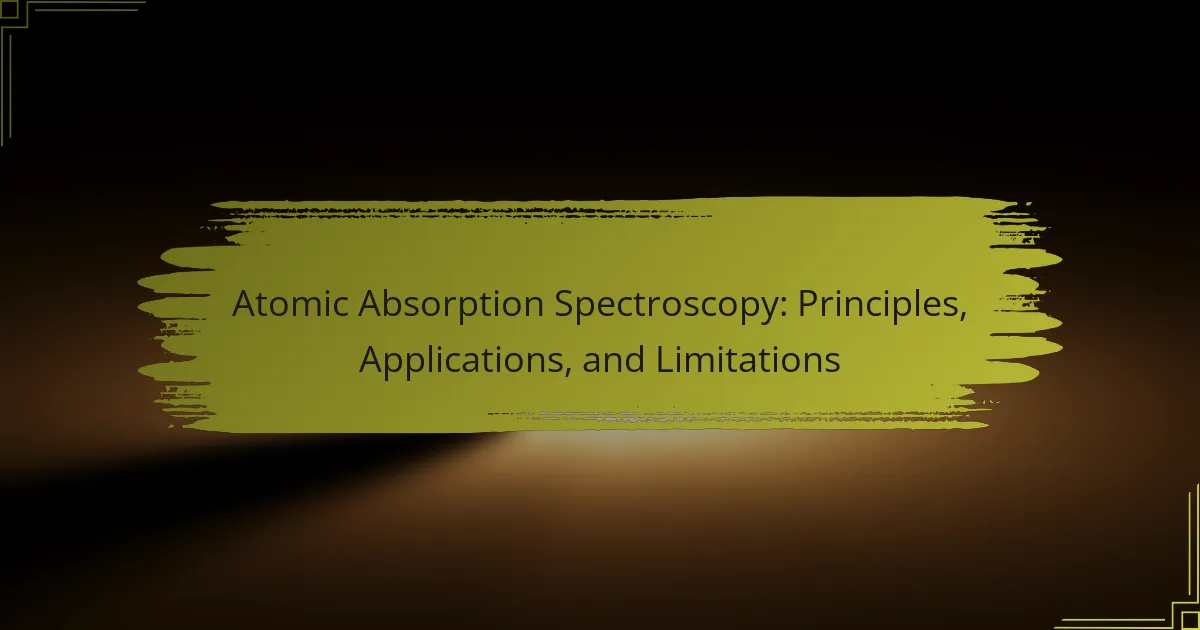
What is Atomic Absorption Spectroscopy?
Atomic Absorption Spectroscopy (AAS) is an analytical technique used to determine the concentration of specific metals in a sample. It works by measuring the absorption of light by free atoms in the gaseous state. AAS is commonly utilized in various fields, such as environmental monitoring and food safety. The technique involves vaporizing a sample and exposing it to a light source. The amount of light absorbed at specific wavelengths correlates to the concentration of the element of interest. AAS is known for its sensitivity and ability to detect trace elements. It provides quantitative results that are crucial for regulatory compliance and quality control.
How does Atomic Absorption Spectroscopy work?
Atomic Absorption Spectroscopy (AAS) works by measuring the absorption of light by free atoms in a gaseous state. A light source emits specific wavelengths of light that correspond to the elements being analyzed. The sample is atomized, typically using a flame or graphite furnace, which converts it into free atoms. These atoms absorb the light at characteristic wavelengths. The amount of light absorbed is proportional to the concentration of the element in the sample. This relationship is described by Beer-Lambert Law, which states that absorbance is directly related to concentration. AAS is widely used for trace metal analysis in various fields, including environmental monitoring and clinical diagnostics.
What are the key components of Atomic Absorption Spectroscopy?
The key components of Atomic Absorption Spectroscopy (AAS) include a light source, atomizer, monochromator, detector, and data processing system. The light source typically consists of hollow cathode lamps, which emit specific wavelengths for different elements. The atomizer converts the sample into free atoms, usually achieved through a flame or graphite furnace. The monochromator isolates the specific wavelength of light absorbed by the atoms. The detector measures the intensity of the transmitted light, allowing for quantification of the analyte. Finally, the data processing system interprets the detector’s signals to produce results. Each component plays a crucial role in the accurate measurement of elemental concentrations.
How does light absorption occur in Atomic Absorption Spectroscopy?
Light absorption in Atomic Absorption Spectroscopy (AAS) occurs when free atoms in a vapor state absorb specific wavelengths of light. The light source typically emits a broad spectrum, but only specific wavelengths match the energy levels of the target atoms. When the light passes through the atomized sample, atoms in the vapor absorb photons corresponding to their unique electronic transitions. This absorption results in a decrease in light intensity, which is measured by a detector. The amount of light absorbed is directly proportional to the concentration of the element in the sample. This principle allows for quantitative analysis of various elements in a sample. AAS is widely used for trace metal analysis in different fields, including environmental monitoring and clinical diagnostics.
What are the principles underlying Atomic Absorption Spectroscopy?
Atomic Absorption Spectroscopy (AAS) is based on the principle of measuring the absorption of light by free atoms. In AAS, a sample is vaporized in a flame or graphite furnace. This process produces free atoms in the gas phase. A light source emits specific wavelengths of light corresponding to the elements of interest.
When the emitted light passes through the vaporized sample, some of it is absorbed by the atoms. The amount of light absorbed is proportional to the concentration of the element in the sample. This relationship is described by Beer-Lambert law, which quantifies how absorbance relates to concentration.
The AAS technique is highly sensitive and can detect trace elements at low concentrations. It is widely used in various fields, including environmental analysis, food safety, and clinical diagnostics.
Why is the Beer-Lambert Law important in Atomic Absorption Spectroscopy?
The Beer-Lambert Law is crucial in Atomic Absorption Spectroscopy because it quantifies the relationship between absorbance and concentration. This law states that absorbance is directly proportional to the concentration of the absorbing species and the path length of the light. In Atomic Absorption Spectroscopy, it allows for the determination of metal concentrations in a sample. Accurate measurements depend on this linear relationship. When the concentration of a sample increases, the absorbance increases correspondingly. This principle enables the calibration of instruments for precise quantitative analysis. The law is validated by extensive empirical data in analytical chemistry. It ensures reliable results in identifying and quantifying elements in various samples.
How do atomic transitions contribute to the spectroscopy process?
Atomic transitions are fundamental to the spectroscopy process. They occur when electrons in an atom move between energy levels. This movement can happen when an atom absorbs or emits electromagnetic radiation. In atomic absorption spectroscopy, specific wavelengths of light are absorbed by atoms, leading to transitions from lower to higher energy states. The absorbed light corresponds to the energy difference between these states.
This absorption creates a spectrum that can be analyzed. Each element has unique energy levels, resulting in distinct absorption lines. These lines allow for the identification and quantification of elements in a sample. The precision of atomic transitions in measuring energy differences ensures accurate spectroscopic readings. Thus, atomic transitions are essential for the effectiveness and specificity of the spectroscopy process.
What are the main applications of Atomic Absorption Spectroscopy?
Atomic Absorption Spectroscopy (AAS) is primarily used for quantitative analysis of metals in various samples. It is widely applied in environmental monitoring to detect heavy metals in water and soil. AAS is also utilized in food safety to measure metal contaminants in food products. In pharmaceutical industries, it helps in determining trace metal levels in drugs. Additionally, AAS is employed in clinical laboratories for analyzing metal concentrations in biological fluids. The method is favored for its sensitivity and accuracy in detecting low concentrations of metals.
Which industries utilize Atomic Absorption Spectroscopy for analysis?
Atomic Absorption Spectroscopy (AAS) is utilized across various industries. These industries include environmental monitoring, agriculture, pharmaceuticals, and food safety. In environmental monitoring, AAS analyzes water and soil samples for heavy metals. Agriculture uses AAS to assess nutrient levels in soil and crops. The pharmaceutical industry employs AAS for quality control of raw materials and final products. Food safety testing often includes AAS to detect contaminants in food products. Each industry relies on AAS for its precision and sensitivity in detecting trace elements.
How is Atomic Absorption Spectroscopy used in environmental monitoring?
Atomic Absorption Spectroscopy (AAS) is used in environmental monitoring to detect and quantify trace metals in various samples. This technique analyzes water, soil, and air samples for pollutants. AAS measures the absorption of light by free atoms in a gaseous state. It provides precise concentration data for elements like lead, mercury, and cadmium. Regulatory agencies often utilize AAS for compliance testing. The method is sensitive and can detect concentrations in the parts per billion range. Studies show AAS is effective for monitoring heavy metal contamination in ecosystems. It supports environmental assessments and pollution control efforts.

What are the limitations of Atomic Absorption Spectroscopy?
Atomic Absorption Spectroscopy (AAS) has several limitations. It is generally limited to detecting metals and some metalloids. AAS cannot analyze non-metals effectively. The technique requires the sample to be in liquid form, which may necessitate complex sample preparation. AAS also suffers from interferences from other elements in the sample. These interferences can lead to inaccurate results. Additionally, AAS has a limited dynamic range compared to other spectroscopic methods. The sensitivity of AAS can vary depending on the element being analyzed. Some elements require specific lamps, which may not be readily available. Lastly, AAS is generally slower than other techniques like Inductively Coupled Plasma (ICP) spectroscopy.
What challenges are faced when using Atomic Absorption Spectroscopy?
Challenges faced when using Atomic Absorption Spectroscopy (AAS) include interference from other elements, matrix effects, and sensitivity limitations. Interference occurs when other elements absorb light at similar wavelengths, impacting accuracy. Matrix effects arise when sample components influence the absorption characteristics, leading to erroneous results. Sensitivity limitations can restrict the detection of trace elements, necessitating pre-concentration steps. Additionally, AAS requires careful calibration and standardization to ensure reliable measurements. These challenges can complicate the analysis and affect the overall effectiveness of AAS in various applications.
How do interferences affect the accuracy of Atomic Absorption Spectroscopy?
Interferences negatively impact the accuracy of Atomic Absorption Spectroscopy (AAS). They can arise from various sources, including spectral and chemical interferences. Spectral interferences occur when overlapping absorption lines affect the measurement of the target analyte. Chemical interferences happen when the presence of other elements alters the ionization or excitation of the analyte.
For instance, the presence of sodium can enhance the ionization of potassium, leading to inaccurate results. Additionally, matrix effects from sample components can also skew measurements. These interferences can lead to either false positives or negatives, compromising the reliability of AAS.
Studies show that the impact of interferences can result in errors exceeding 10% in some cases, making it critical to identify and mitigate them for accurate results.
What are the limitations in detecting certain elements with Atomic Absorption Spectroscopy?
Atomic Absorption Spectroscopy (AAS) has limitations in detecting certain elements. Some elements may not absorb light effectively due to low atomic absorption cross-sections. This results in weak signals that are difficult to quantify accurately. Additionally, elements with similar spectral lines can lead to spectral interference. This interference complicates the detection and quantification process. Furthermore, AAS is less effective for non-metals and light elements like hydrogen and helium. These elements often require different analytical techniques for accurate detection. AAS also has a limited dynamic range, affecting its ability to measure very high or very low concentrations. Lastly, the presence of matrix effects can alter the absorption characteristics, leading to inaccurate results.
How can the limitations of Atomic Absorption Spectroscopy be mitigated?
Limitations of Atomic Absorption Spectroscopy (AAS) can be mitigated by employing several strategies. One effective method is using a more sensitive detection system. This can enhance the ability to detect lower concentrations of analytes. Additionally, optimizing the nebulization process improves sample introduction efficiency. Improved atomization techniques, such as using a graphite furnace, can also increase sensitivity and reduce interferences.
Furthermore, employing background correction methods can help minimize spectral interferences. Utilizing different wavelengths for analysis can reduce the likelihood of overlapping signals. Regular calibration with standard solutions ensures accurate measurements and compensates for instrument drift. Finally, using matrix modifiers can help reduce the effects of sample matrix on the analytical results. These approaches collectively enhance the reliability and accuracy of AAS results.
What techniques can enhance the effectiveness of Atomic Absorption Spectroscopy?
Techniques that can enhance the effectiveness of Atomic Absorption Spectroscopy (AAS) include the use of a flame or electrothermal atomization. Flame atomization provides a quick and efficient way to vaporize samples, allowing for rapid analysis. Electrothermal atomization, on the other hand, offers higher sensitivity and is suitable for trace analysis.
Additionally, the use of background correction techniques, such as Zeeman effect or Smith-Hieftje method, improves accuracy by compensating for interference from the matrix. Implementing a multi-element analysis capability allows simultaneous detection of multiple elements, increasing throughput.
Optimizing the nebulizer design enhances sample introduction efficiency. Finally, employing advanced data processing techniques, such as chemometrics, improves the interpretation of complex spectra. These enhancements collectively lead to more reliable and precise results in AAS.

What best practices should be followed when using Atomic Absorption Spectroscopy?
Ensure proper calibration of the Atomic Absorption Spectroscopy (AAS) instrument before use. Calibration should be performed using standard solutions that match the expected sample matrix. Regularly check the lamp’s intensity and replace it as needed to maintain accuracy. Use appropriate sample preparation techniques to avoid contamination and ensure representative sampling. Maintain consistent operating conditions, such as temperature and flow rates, to enhance reproducibility. Follow safety protocols to handle chemicals and samples correctly. Document all procedures and results meticulously for traceability and validation. These practices help achieve reliable and accurate results in AAS analysis.
How can one ensure accurate results in Atomic Absorption Spectroscopy?
To ensure accurate results in Atomic Absorption Spectroscopy (AAS), proper calibration and maintenance of the instrument are essential. Regularly calibrating the AAS with standard solutions helps establish a reliable baseline for measurements. Using high-purity reagents minimizes contamination and enhances accuracy. Sample preparation should be meticulous, ensuring samples are free from interferences. Consistent operational conditions, such as flame temperature and gas flow rates, are vital for reproducibility. Additionally, employing quality control measures, like running blanks and duplicates, verifies the reliability of results. These practices collectively enhance the precision and accuracy of AAS measurements.
What common troubleshooting steps can be taken when issues arise in Atomic Absorption Spectroscopy?
Common troubleshooting steps for Atomic Absorption Spectroscopy (AAS) issues include checking the lamp alignment and condition. A misaligned or aged lamp can lead to weak signals. Inspecting the sample preparation is crucial, as improper dilution or contamination affects results. Verify the flame conditions, ensuring the correct fuel and oxidant flow rates. Calibration standards must be fresh and accurately prepared, as old standards can skew results. Regularly clean the atomizer to prevent blockages that can disrupt analysis. Additionally, ensure the detector is functioning properly to maintain signal integrity. Finally, review the software settings and instrument parameters to confirm they are correctly configured for the analysis.
Atomic Absorption Spectroscopy (AAS) is an analytical technique used to determine the concentration of specific metals in various samples by measuring light absorption by free atoms in a gaseous state. The article covers the principles underlying AAS, including the Beer-Lambert Law, key components of the technique, and its applications in fields such as environmental monitoring, food safety, and pharmaceuticals. It also discusses the limitations and challenges faced when using AAS, such as interferences and detection constraints, along with strategies to mitigate these issues. Best practices for ensuring accurate results in AAS are highlighted to enhance reliability and precision in measurements.
